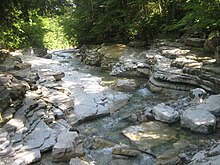Tauglgries
The Tauglgries is a nature reserve and a Natura 2000 area in the municipalities of Bad Vigaun and Kuchl in the state of Salzburg ( Hallein district ) in Austria . It covers 31.9 hectares along a 2.4-kilometer section of the Taugl River and its banks.
Ecological importance
In the standard data sheet for the protected area according to the Fauna-Flora-Habitat Directive ("FFH area" for short), the Tauglgries is characterized as a "dynamic wild river with wide gravel banks and corresponding bank vegetation ( butterbur , willow trees), on the slopes, in part, species-rich canyon forest areas".
The ecological significance of “Unique, near-natural preserved and largely intact wild river landscape with extensive relocation areas and furcation stretches is of Austria-wide significance. Buildings are almost completely missing. Large vegetation-free sand and gravel banks provide a habitat for a specially adapted animal world that specializes in open ground structures. In Tauglgries z. B. the only known Salzburg occurrence of Corthippus pullus and Oedipoda caerulescens . In the edge area of the gravel banks there are well defined butterbur meadows and lavender bushes. There are sometimes species-rich canyon forest areas “described on the hooks.
According to the project description for the creation of the management plan for the Tauglgries Natura 2000 area, the gravel and sand areas, which are mostly poor in vegetation, due to the great creative power of the stream, offer habitat for specially adapted bird species, such as the little ringed plover and sandpiper or rare insect and spider species.
Protected goods
The following habitat types of European importance are protected in the FFH area:
- Alpine rivers with herbaceous bank vegetation, code: 3220
- Alpine rivers with riparian trees from Salix elaeagnos , code: 3240
- Central European orchid-lime-beech forest ( Cephalanthero-Fagion ), code: 9150
- Mixed ravine and hillside forests ( Tilio-Acerion ), Code: 9180, priority protection
- Floodplain forests with Alnus glutinosa and Fraxinus excelsior ( Alno-Padion , Alnion incanae , Salicion albae ), code: 91E0, priority property
The Natura 2000 area "Tauglgries" is only designated according to the Fauna-Flora-Habitat Directive and not the Bird Protection Directive . Even so, 86% of the species listed in the standard data sheet that the area was designated to conserve are birds. The following species are listed as objects of protection in the FFH area "Tauglgries" in the standard data sheet: Common swift ( Apus apus ), little ringed plover ( Charadrius dubius ), wood pigeon ( Columba palumbus ), bullhead ( Cottus gobio ), yellow lady's slipper ( Cypripedium calceolus ), Mehlschwalbe ( Delichon urbicum ), Barn swallow ( Hirundo rustica ), Bachstelze ( Motacilla alba ), wagtail ( Motacilla cinerea ), Grauschnäpper ( Muscicapa striata ) Zilpzalp ( Phylloscopus collybita ) Fitis ( Phylloscopus trochilus ) Mönchsgrasmücke ( Sylvia atricapilla ) and thrush ( Turdus philomelos ).
Protection categories and area designations
In 2000, an area of 31.9 hectares was designated as a “Protected Part of the Landscape”.
The designation as an FFH area took place in the same area in 2007.
Interventions and endangerment
In recent years, recreational use in the protected area has increased and at the same time the number of endangered species has decreased, which is why protection zones have been defined that are not allowed to be entered during the reproduction period. This entry ban enshrined in the regional ordinance was first circumvented with a two-year special permit, which was subsequently granted for an unlimited period (2012).
In the meantime (as of 2012) the little ringed plover ( Charadrius dubius ) has disappeared in the protected area, the blue-winged wasteland cricket ( Oedipoda caerulescens ) has become extinct, the gravel bank grasshopper ( Chorthippus pullus ) is, according to current genetic studies, severely weakened and acutely threatened with extinction. Thus, the short-feeler terrors (Caelifera) highlighted separately in the description of the ecological significance of the protected area have remained unprotected in the protected area established for them.
Web links
Individual evidence
- ↑ a b European Environment Agency (2014): Standard data sheet on the FFH area "Tauglgries" (AT3212111) , accessed on July 9, 2014
- ↑ Umweltbüro GmbH (2010): Project description for the creation of a management plan for the nature and European reserve "Tauglgries", 2 pp. [PDF]
- ↑ a b Jaritz, G. (Ed., 2012): Management plan for nature and European conservation area “Tauglgries”, short version, 36 pp. [PDF]
- ↑ Pointinger, M. (2012): Article “Tauglgries - European Protected Area on the Test Stand, Critical Consideration”. In: Natur & Land, issue 3-2012, p. 42 ( Memento of the original from July 14, 2014 in the Internet Archive ) Info: The archive link was inserted automatically and has not yet been checked. Please check the original and archive link according to the instructions and then remove this notice. [PDF]
- ↑ a b Pointinger, M. (2012): Article "Tauglgries European Protected Area at the VwGH test stand - In the area of tension between recreational use and extinction of species", State Environmental Prosecutor Salzburg. In: LUA Notes, issue 2-2012, p. 3 [PDF, 2.7 MB]
Coordinates: 47 ° 39 ′ 26.5 ″ N , 13 ° 8 ′ 39.6 ″ E
